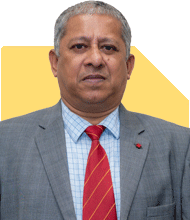
I am Sunil 36 years old male. I have my wife, daughter aged 4 and widow mother in my family who are dependent on me financially. I am a central government employee since last 18 years with a Salary of Rs 90000 per month. As I started earning at the age of 18 years, I wish to retire from my current organisation in June 2026 after 1 year and 9 months. I will be getting around Rs 50,00,000 at the time of retirement which includes my Provident fund and Leave encashment. I will get a monthly pension of Rs 30000 after that. Our current monthly expenses are Rs. 35000. I own a house but it requires some work which may cost around 20 Lakh from my retirement fund and I will be left with 30 Lakhs in hand after retirement in June 2026. I will have around 3 Lakh in Mutual Funds till that time and have Sukanya Smridhi Yojna for my daughter which is amount 118000 now and i am contributing Rs 2500 per month in that. I and my wife own Gold in the form of jewellery amounting to Rs 5 lakh (current value). I wish to know regarding am I taking a correct decision by leaving the govt job at the age of 38 ? Next I am willing to work in some other Organisation if I found it interesting. Thanks in advance for suitable advice.
Ans: Your situation is unique because you’ve started earning early and have built a solid foundation. Retiring at 38 is an ambitious goal, and it’s important to evaluate the long-term financial and lifestyle impact carefully.
1. Financial Preparedness for Early Retirement
You’ll receive Rs 50 lakh upon retirement, with Rs 20 lakh allocated for house repairs, leaving Rs 30 lakh. You will also receive a monthly pension of Rs 30,000, while your current expenses are Rs 35,000 per month. Let’s explore how this balance plays out.
Gap in Income and Expenses: Your pension will cover Rs 30,000 of your Rs 35,000 expenses. This leaves a gap of Rs 5,000, which might seem small, but over the long term, it can create pressure on your savings. Inflation will also push your monthly expenses higher.
Emergency Buffer: With Rs 30 lakh in savings after house repairs, you’ll need to make sure that these funds grow over time and aren’t depleted too quickly. If your monthly expenses grow due to inflation or unforeseen events, you may need to rely on this corpus sooner than expected.
It’s essential to plan for inflation and future financial needs. You may want to continue building your investment portfolio to ensure it grows in line with inflation.
2. Pension and Investment Strategy Post-Retirement
After retiring, you will still have around Rs 30 lakh, a pension of Rs 30,000, and Rs 3 lakh in mutual funds by 2026. Here’s what you can do to optimize your financial situation:
Investment of Retirement Corpus: After using Rs 20 lakh for house repairs, the remaining Rs 30 lakh should be invested wisely. Since you will still have a long time horizon post-retirement, consider investing a part of this amount in a mix of equity mutual funds and debt funds. Equity will help your money grow faster, while debt can provide stability.
Sukanya Samriddhi Yojana for Daughter’s Education: Your existing contribution of Rs 2,500 per month is a good move for your daughter’s future. This investment will grow over time, helping you meet her educational needs without straining other parts of your finances.
3. Evaluating Future Employment Opportunities
You mentioned that you are open to working in another organization if you find it interesting after retirement. This is a prudent approach:
Bridging Financial Gaps: If you find another job, even a part-time role, the extra income can help bridge the Rs 5,000 gap in your pension and expenses. It would also reduce the need to dip into your Rs 30 lakh corpus too early.
Flexibility and Job Satisfaction: Retirement doesn’t have to mean stopping work entirely. Finding a job or consultancy role that excites you can offer flexibility and satisfaction without the pressure of a full-time commitment.
4. Expenses and Financial Goals
Your current monthly expenses are Rs 35,000, which seems manageable within your pension and investment returns. However, you should consider these points for future financial security:
Children’s Education Costs: Your daughter is only 4 years old now, but her educational expenses will increase over time. Planning ahead for this increase, either through targeted investments or dedicated funds like Sukanya Samriddhi Yojana, will be crucial.
House Repair and Lifestyle Costs: Allocating Rs 20 lakh for house repairs is a significant expenditure. Make sure you have accounted for all repair costs, including possible overruns. Also, consider how any lifestyle changes post-retirement (such as travel or hobbies) may impact your financial plan.
5. Inflation and Long-Term Planning
Over the next few decades, inflation will erode the value of your pension and savings if not managed properly. Here’s how to counteract this:
Equity Investments for Growth: Since you’re retiring early, your retirement fund needs to last several decades. A portion of your Rs 30 lakh corpus should be invested in equity mutual funds to beat inflation. Consider actively managed funds for better returns in the long run.
Debt for Stability: While equity investments are important for growth, it’s also crucial to have some stability in your portfolio. A portion of your funds should be invested in debt mutual funds or fixed-income instruments for predictable returns and low risk.
6. Avoiding Over-Reliance on Pension
While your pension of Rs 30,000 will cover most of your monthly expenses, you cannot rely solely on it for the long term. With inflation increasing expenses, the Rs 30,000 may not be sufficient in 10 or 15 years.
Supplementing Pension with Investments: By carefully investing your Rs 30 lakh corpus and building a balanced portfolio, you can generate additional income to supplement your pension. This way, you won’t have to worry about future shortfalls in your monthly expenses.
7. Gold as a Financial Asset
You own gold worth Rs 5 lakh, which is a good backup asset. However, gold should be viewed more as an emergency resource rather than a primary investment.
Avoid Over-Reliance on Gold: While gold can provide financial security, it doesn’t generate income or high returns over time like mutual funds or other growth investments. Keep this gold for future needs or emergencies, but don’t depend on it for regular expenses.
8. Considering Long-Term Financial Security
Since you’ll be retiring at a young age, it’s important to think about long-term financial security:
Health and Insurance Costs: With early retirement, medical expenses could become significant over time. Ensure you have adequate health insurance for yourself and your family. Consider a term life insurance policy to protect your dependents in case of any unforeseen event.
Building Emergency Fund: You’ll need to set aside a part of your Rs 30 lakh corpus for emergencies. This fund should cover at least 6 to 12 months of expenses, including unexpected health or lifestyle costs.
9. Active vs. Passive Investments
When investing the remaining Rs 30 lakh, it’s better to avoid passive investment options like index funds, which merely track the market. You’ll need more active management to ensure consistent growth, especially considering your early retirement.
Disadvantages of Index Funds: Index funds can underperform during bear markets since they mirror the entire market. Actively managed funds can adapt and outperform under changing market conditions. Given your situation, an actively managed portfolio will be more beneficial in delivering higher returns over the long term.
Final Insights
Sunil, your decision to retire at 38 is bold and achievable with the right planning. You’ve built a strong financial base, but there are key steps to ensure that your retirement is smooth and stress-free.
Invest your Rs 30 lakh corpus in a mix of equity and debt mutual funds to ensure both growth and stability.
Supplement your pension with additional income, either through part-time work or investment returns.
Plan for inflation, future expenses, and emergencies with a diversified investment strategy.
Keep your financial goals in mind, continue contributing to your daughter’s education fund, and ensure that your family’s long-term security is well-protected.
Best Regards,
K. Ramalingam, MBA, CFP,
Chief Financial Planner,
www.holisticinvestment.in
https://www.youtube.com/@HolisticInvestment
























